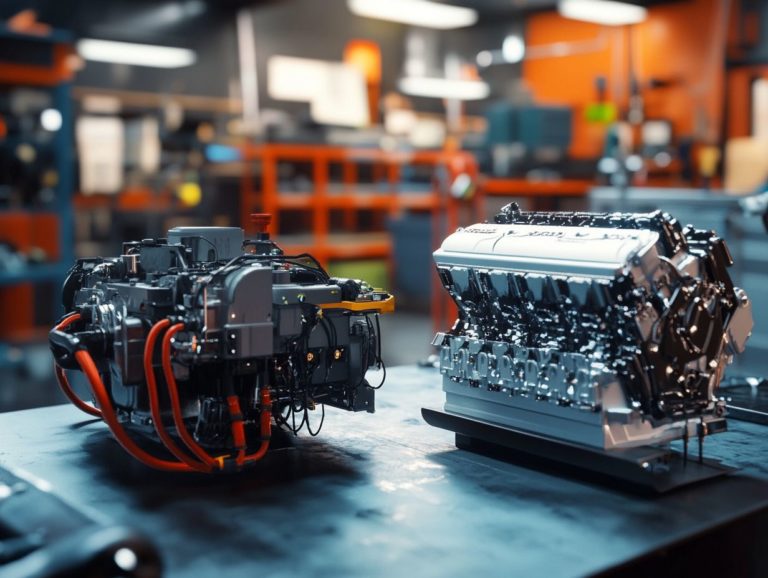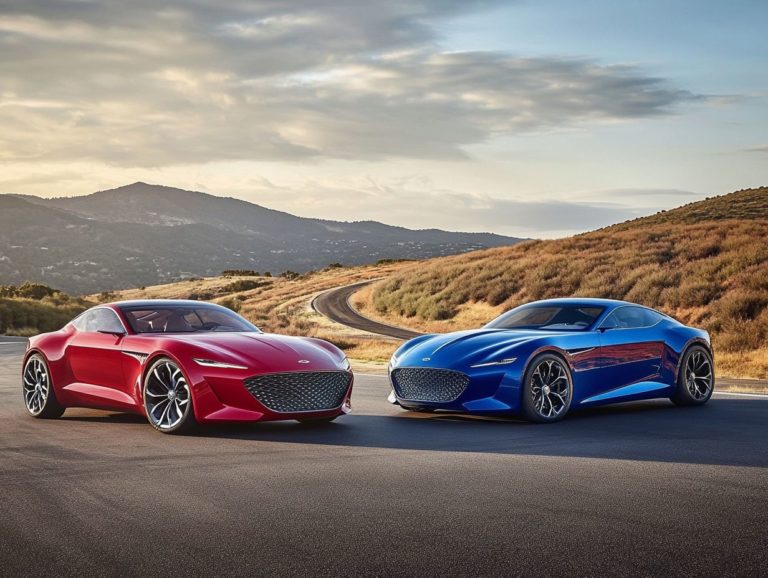Best Fuel Efficiency Features in 2024 Cars
As the automotive industry continues to evolve, fuel efficiency stands out as a paramount concern for manufacturers and consumers like you.
The 2024 lineup of vehicles showcases an impressive array of innovative features crafted to maximize mileage while reducing environmental impact. These advancements redefine your driving experience.
This article invites you to explore the finest fuel efficiency features in 2024 cars, equipping you with the insights you need to make an informed choice for your next vehicle.
Contents
- Key Takeaways:
- Best Fuel Efficiency Features in 2024 Cars
- 1. Electric and Hybrid Options
- 2. Regenerative Braking Systems
- 3. Start-Stop Technology
- 4. Low Rolling Resistance Tires
- 5. Aerodynamic Design
- 6. Lightweight Materials
- 7. Improved Engine Efficiency
- 8. Continuously Variable Transmissions
- 9. Eco Mode Feature
- 10. Advanced Driver Assistance Systems
- 11. Energy-Efficient Climate Control
- 12. Auto-Start-Stop Function
- 13. Cylinder Deactivation
- 14. Fuel-Efficient Navigation Systems
- 15. Solar-Powered Features
- Frequently Asked Questions
- What are the best fuel efficiency features in 2024 cars?
- How do electric or hybrid engines contribute to fuel efficiency in 2024 cars?
- What are advanced aerodynamics and how do they improve fuel efficiency in 2024 cars?
- What is a start-stop system?
- Benefits of Regenerative Braking Systems
- How to Get the Best Fuel Efficiency from Your 2024 Car
Key Takeaways:
- Electric and hybrid options are top choices for fuel efficiency in 2024, with advancements making them more accessible.
- Regenerative braking systems recharge the battery during braking, boosting fuel efficiency.
- Start-stop technology shuts off the engine at stops, cutting fuel use and emissions.
Best Fuel Efficiency Features in 2024 Cars
As the automotive industry embraces sustainable transportation solutions, you’ll find that 2024 cars come equipped with innovative features designed to maximize fuel efficiency while minimizing carbon emissions. For more insights, check out what to expect from new car features in 2024. This shift benefits eco-conscious drivers and environmentally aware consumers alike.
These advancements not only enhance gas mileage but also introduce cutting-edge technologies, making them some of the best vehicles for new drivers in 2024, which elevate your driving experience and offer cost-effective transportation.
Among these innovations, hybrid powertrains stand out, providing the perfect combination of electric and gasoline power for efficient navigation through city streets and highways.
Turbocharging is another remarkable feature. It enables smaller engines to deliver impressive performance without compromising fuel consumption.
By adopting smart driving habits like smooth acceleration and maintaining steady speeds you can further boost your fuel economy. Embracing these technologies is vital in reducing greenhouse gas emissions, aligning with global environmental initiatives that tackle climate change and pave the way for a greener future for generations to come.
1. Electric and Hybrid Options
With increasing focus on reducing carbon emissions, electric and hybrid options like the Toyota Prius, Honda Civic, and Hyundai Ioniq stand out as stellar choices. Additionally, if you’re interested in the latest advancements, the best tech features in 2024 luxury sedans are worth exploring for a blend of performance and innovation.
These vehicles offer impressive MPG ratings that allow you to travel longer distances on less fuel. For example, the Toyota Prius often boasts a combined rating of over 50 MPG, making it a standout in the hybrid arena.
The Honda Civic’s hybrid variant employs advanced technologies to optimize performance, adapting seamlessly to various driving situations, whether you’re navigating stop-and-go traffic or cruising down the highway.
Then there’s the Hyundai Ioniq, which features a lightweight design and efficient electric drivetrain, enhancing both speed and economy. This helps you reduce your overall environmental footprint without sacrificing performance.
These innovations contribute to lower gas consumption and represent a significant leap toward achieving sustainable mobility.
2. Regenerative Braking Systems
Regenerative braking systems in hybrid vehicles mark a remarkable leap in energy conversion technology. They enable you to capture and reuse energy that would otherwise vanish during braking.
This technology significantly enhances your overall fuel efficiency while improving your driving experience.
By converting kinetic energy back into stored electrical energy, these systems not only improve your mileage but also help in reducing overall fuel consumption.
Vehicles like the Toyota Prius and Honda Insight exemplify this technology, showcasing lower carbon emissions that contribute to a cleaner environment.
As a consumer, you may find yourself increasingly attracted to these eco-friendly options. They provide economic savings alongside the gratifying experience of supporting sustainable practices.
The enhanced driving dynamics of these vehicles appeal to those seeking advanced features that seamlessly blend efficiency with performance.
3. Start-Stop Technology
Start-stop technology is an impressive feature that automatically turns off your engine during stops, like at traffic lights, to cut down on gas consumption and greatly improve fuel savings in urban driving scenarios.
This system effortlessly restarts the engine when you release the brake pedal, enabling more efficient fuel use in congested city environments where stops are the norm. By minimizing idle time, it conserves energy and contributes to lower emissions.
To fully harness the advantages of this technology, adopting smooth driving habits is essential. Techniques like gentle acceleration and smooth deceleration can greatly improve the system’s effectiveness, allowing you to maximize fuel efficiency while enjoying a more environmentally friendly driving experience.
4. Low Rolling Resistance Tires
Low rolling resistance tires are carefully made to minimize energy loss as you drive, greatly improving your fuel economy and gas mileage under various driving conditions.
These specialized tires use advanced materials and innovative tread designs to reduce friction between the tire and the road. Unlike standard tires, which create more drag, low rolling resistance options allow your vehicle to glide effortlessly, requiring less energy to maintain speed.
This means you ll notice real savings at the pump while also making an important choice for sustainable transportation solutions. By choosing low rolling resistance tires, you can reduce your carbon footprint and enhance your vehicle’s performance and efficiency.
5. Aerodynamic Design
Aerodynamic design is crucial for improving fuel efficiency, especially as vehicles be it compact cars, midsize sedans, or SUVs are increasingly shaped to minimize drag and boost gas mileage through cutting-edge technology.
This careful approach includes various elements, such as sleek body shapes designed to reduce wind resistance, along with strategically placed spoilers that help stabilize airflow. Air intakes are crafted to optimize engine cooling while maintaining peak performance, contributing to a more aerodynamic profile.
Vehicles like the Toyota Prius and Tesla Model 3 exemplify these design principles, showcasing significant improvements in fuel economy and reductions in carbon emissions. For those interested in greener options, the top 7 eco-friendly new cars of 2024 highlight how manufacturers prioritize aerodynamic features to elevate efficiency and move towards a more sustainable transportation future.
6. Lightweight Materials
The use of lightweight materials in vehicle manufacturing is a game-changer for fuel efficiency, allowing you to enjoy energy-efficient vehicles without sacrificing safety or comfort. By incorporating advanced technologies, automakers can significantly reduce weight while maintaining high standards.
Materials like aluminum and carbon fiber are essential players in this transformation. Their exceptional strength-to-weight ratios enable manufacturers to achieve impressive weight reductions, paving the way for better performance. Vehicles like the Ford F-150 and Tesla Model S showcase how these innovations enhance performance and lead to remarkable improvements in fuel economy.
Get ready for an exciting boost in your driving experience with increased agility and more responsive handling across various terrains!
7. Improved Engine Efficiency
Improved engine efficiency, particularly through innovations like turbocharging a technology that boosts engine power without using more fuel allows you to enjoy more power while using less fuel overall for every mile you drive.
This advancement leads to savings at the pump and elevates overall performance, giving you the thrill of brisk acceleration without the guilt of excessive fuel use. Hybrid powertrains combine gasoline engines with electric motors, optimizing power delivery and lowering emissions.
These technologies work together to create a more enjoyable driving experience, enabling seamless transitions between power sources and smoother acceleration. Ultimately, advancements in engine technology are transforming how you perceive vehicle performance and environmental responsibility, guiding you toward smarter choices on the road.
8. Continuously Variable Transmissions
Continuously variable transmissions (CVTs) provide a seamless driving experience with an infinite range of gear ratios. This innovation improves performance and boosts fuel efficiency.
Unlike traditional automatic transmissions, which use fixed gears, CVTs adjust to changes in driving conditions. This allows your engine to operate at its optimal revolutions per minute (RPM) for smooth acceleration.
As a consumer, you ll appreciate how these advancements lead to better fuel economy. With increasing awareness of vehicles’ environmental impact, more drivers are choosing CVTs.
9. Eco Mode Feature
The eco mode feature in modern vehicles is designed to optimize engine performance and driving dynamics. It helps you maximize fuel economy, making it invaluable for eco-conscious drivers.
By fine-tuning throttle response, adjusting transmission shift points, and modifying climate control settings, eco mode creates smoother acceleration and deceleration. Popular vehicles like the Honda Accord, Toyota Camry, and Ford Fusion are known for their great eco mode features.
Using eco mode encourages efficient driving habits, such as maintaining steady speeds and reducing aggressive driving. The payoff? You enjoy improved fuel savings and a quieter, more enjoyable ride that supports a healthier environment!
10. Advanced Driver Assistance Systems
Advanced driver assistance systems (ADAS) use advanced technology to enhance vehicle safety and fuel efficiency. They guide you toward eco-friendly driving habits that help reduce emissions.
With features like adaptive cruise control and lane-keeping assistance, these systems maintain a steady speed while adjusting to traffic. This minimizes sudden acceleration or braking, which can heavily impact fuel consumption.
As you recognize these advantages, your preferences may shift toward vehicles equipped with ADAS, increasing demand for safer cars. Ultimately, these systems enhance your safety on the road and promote responsible driving aligned with environmental goals.
11. Energy-Efficient Climate Control
Energy-efficient climate control systems in vehicles minimize energy consumption while ensuring a comfortable cabin environment. This enhances your overall fuel economy and your driving experience.
Using advanced technologies like variable-speed compressors and smart climate management, these systems adjust temperature settings based on real-time cabin needs, relieving stress on the engine. Hybrid models like the Toyota Prius showcase these advancements, allowing eco-conscious drivers to enjoy a more sustainable ride without sacrificing comfort.
Electric vehicles, such as the Tesla Model 3, utilize sophisticated heat pump systems to optimize climate control, significantly reducing energy usage. Embracing these technologies supports efficient driving for those dedicated to minimizing their environmental impact.
12. Auto-Start-Stop Function
The auto-start-stop function is a practical feature that automatically shuts off the engine when your vehicle is stationary. This helps save fuel during stop-and-go driving.
This innovative technology activates at traffic lights, during long stops, or while idling in heavy traffic. It effectively minimizes unnecessary fuel consumption. When you press the accelerator, the engine restarts seamlessly, ensuring a smooth transition back to driving.
This is especially beneficial in urban settings, where frequent stops due to traffic congestion are common, showcasing its effectiveness.
As you become more eco-conscious, the allure of this feature increases. It often influences your purchasing decisions as you weigh sustainability against traditional performance metrics.
13. Cylinder Deactivation
Cylinder deactivation technology allows your engine to temporarily shut down some cylinders under specific driving conditions. This results in enhanced fuel savings and overall efficiency in fuel-efficient vehicles.
This system shines during highway driving, where maintaining a consistent speed yields impressive gains in fuel economy. By using fewer cylinders when full power isn’t necessary, you can enjoy extended travel between fill-ups.
Modern vehicles, like the Chevrolet Silverado and the Dodge Ram 1500, have embraced this feature. It appeals to those seeking a balance between power and efficiency, making your driving experience more economical while contributing to an environmentally friendly ride.
Fuel-efficient navigation systems help you optimize your routes for better fuel economy. They enable you to adopt driving habits that can lead to significant reductions in gas consumption.
These advanced systems tap into real-time traffic updates, steering you clear of congested areas and guiding you toward the most fuel-efficient paths available. They quickly analyze traffic to find the best routes, helping you save fuel and time!
Many of these systems include eco-driving tips that encourage smooth acceleration and braking. This technology leads to impressive fuel savings and fosters eco-friendly driving habits, significantly lowering your carbon footprint and benefiting the environment.
15. Solar-Powered Features
Solar-powered features in vehicles represent a remarkable stride toward harnessing renewable energy. They offer you eco-friendly driving options that elevate sustainability and reduce dependence on traditional energy sources.
By incorporating solar panels into roofs and windows, these vehicles can capture sunlight and convert it into electricity. This energy powers onboard systems, charges batteries, or even assists with propulsion, leading to enhanced energy efficiency and a significant reduction in greenhouse gas emissions.
As advancements in solar technology unfold, the automotive industry envisions a future where vehicles primarily operate on solar energy. This shift could fundamentally change how you perceive energy consumption and its impact on the environment.
Frequently Asked Questions
What are the best fuel efficiency features in 2024 cars?
Top fuel-saving features in 2024 cars include electric engines, smart aerodynamics, and advanced braking systems.
How do electric or hybrid engines contribute to fuel efficiency in 2024 cars?
Electric or hybrid engines use electricity as their primary power source, reducing gasoline use and improving fuel efficiency. They also feature regenerative braking, which recycles energy lost during braking.
What are advanced aerodynamics and how do they improve fuel efficiency in 2024 cars?
Advanced aerodynamics refer to the design of a car’s body to reduce drag and improve airflow. This results in less resistance while driving, leading to better fuel efficiency.
What is a start-stop system?
A start-stop system automatically turns off the engine when your car is idle, like at a stoplight. This feature cuts fuel consumption and emissions, making it popular in 2024 cars. For those seeking efficiency, checking user ratings of the most fuel-efficient SUVs of 2023 can provide valuable insights.
Benefits of Regenerative Braking Systems
Regenerative braking systems capture energy usually lost during braking. They recycle this energy to power the car, which boosts fuel efficiency.
How to Get the Best Fuel Efficiency from Your 2024 Car
To maximize fuel efficiency, maintain your car with regular tune-ups and tire rotations.
Practice fuel-efficient habits, like avoiding rapid acceleration and keeping a steady speed.





